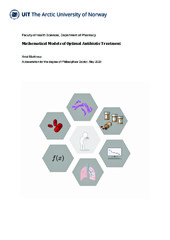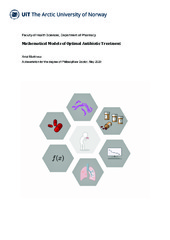| dc.contributor.advisor | Abel zur Wiesch, Pia | |
| dc.contributor.author | Martinecz, Antal | |
| dc.date.accessioned | 2020-05-14T21:11:01Z | |
| dc.date.available | 2020-05-14T21:11:01Z | |
| dc.date.issued | 2020-06-09 | |
| dc.description.abstract | When bacteria are exposed to antibiotics, the rate of killing can slow down dramatically over time. This phenomenon can be observed both in vitro and in vivo. In vitro, the mechanistic explanations for this can be divided into two main categories: antibiotic persistence and heteroresistance. In vivo, both mechanisms thought to contribute to observed slowdowns in the elimination and as a result may prolong the necessary treatment lengths. Therefore, by mitigating the slowdown it might be possible to shorten antibiotic treatments, however this is yet to be shown conclusively. This is also the case in tuberculosis when treatment regimens take at least 6 months.
This thesis focuses on heteroresistance and its effects on the treatments lengths necessary to eliminate bacteria, particularly in the treatment of tuberculosis. To do so, I expand the mathematical toolbox of modeling heteroresistance on different scales, ranging from modeling chemical reaction kinetics to modeling multiple bacterial colonies within the tissues of patients. In addition, I analyzed clinical trials on high rifampicin doses in tuberculosis patients to show that heteroresistance the likely cause of the observed slowdown in elimination within the trial. | en_US |
| dc.description.doctoraltype | ph.d. | en_US |
| dc.description.popularabstract | Tuberculosis (TB) is a deadly disease that results in 1.5 million related deaths worldwide each year. Due to the complexities of the disease, even for the drug susceptible form, the treatment takes six months and requires a cocktail of four different antibiotics. For those who are infected with drug resistant strains, or cases where the bacteria developed drug resistance to the key drugs during and after (unsuccessful) treatments, the treatment regimens take even longer. In the drug resistant case, the length of treatment, the perceived and real stigma associated with the disease, and the side-effects of treatment itself on top of the disease makes it a miserable experience. As one patient summed up in a study: “I cry every day”. Arguably, by improving the treatment success rates and effectiveness of the for the drug susceptible tuberculosis treatments, the prevalence of drug resistant cases can also be reduced.
Improving treatments however is a complex issue. This problem is well illustrated by the fact that even though of one of the current key drugs, rifampicin, has been introduced for the treatment of tuberculosis in the late 1960s, its use still not optimized. As a result, there are still clinical trials aimed at finding optimal treatment regimens, strategies, or dosing.
Optimizing the use of antibiotics faces multiple challenges, one of which is the apparent slowdown in elimination rates of bacteria. When bacteria are exposed to antibiotics, the majority of bacteria can often be killed rapidly, however the remaining bacteria may take a long time to be killed. It is often assumed that this slowdown can affect the treatment of patients, however has not been proven conclusively. This is partly because during treatments the immune system eliminates bacteria as well in addition to antibiotics. The impact of the immune system is well illustrated by the fact that bacteriostatic antibiotics (antibiotics that only prevent the replication of bacteria) often work just as well for treatments as bactericidal antibiotics (antibiotics that kill bacteria). In tuberculosis it has been shown that in “successful treatments” (no relapse after the termination of treatment), viable bacteria may still exist in the patients. In addition to knowledge gaps in modeling the immune system, and the behavior of bacteria in vivo in general, our ability to evaluate and analyze these problems is hindered by our ability to measure the amount of bacteria (bacterial loads) in patients. In tuberculosis for example, bacterial loads in patients are assessed via sputum bacterial count measurements which only offer an incomplete picture. This is well illustrated by the fact that even though there are no bacteria detected in the sputum after the first 2-3 months of the treatment, it is necessary to treat for the full 6 months in order to avoid relapse. In cases where direct measurements are not possible, mathematical modeling approaches have been shown to be useful in the decision making processes. As a result, in recent years theoretical and modeling approaches have been on the rise in tuberculosis clinical trials as well, complementing the traditionally empirical approaches in the field in order to further optimize treatments.
In this thesis I expand the mathematical toolbox of modeling the slowdown in elimination. I use these methods to analyze a clinical trial on high rifampicin doses in tuberculosis treatments in order to assess the impact and possible mechanical causes of the observed slowdown in bacterial elimination within the trial. Ultimately, these results and approaches contribute to our understanding why certain treatment approaches are more effective than others and as a result aid in optimizing current and future treatment regimens. | en_US |
| dc.description.sponsorship | The salary of Antal Martinecz was funded by University of Tromsø. The running costs of the PhD as well as the salary of the main supervisor, Pia Abel zur Wiesch, was funded by the Research Council of Norway (NFR), grant number 262686. | en_US |
| dc.identifier.isbn | 978-82-7589-675-7 | |
| dc.identifier.uri | https://hdl.handle.net/10037/18291 | |
| dc.language.iso | eng | en_US |
| dc.publisher | UiT The Arctic University of Norway | en_US |
| dc.publisher | UiT Norges arktiske universitet | en_US |
| dc.relation.haspart | <p>Paper 1: Clarelli, F., Liang, J., Martinecz, A., Heiland, I. & Abel zur Wiesch, P. (2020). Multi-scale modeling of drug binding kinetics to predict drug efficacy. <i>Cellular and Molecular Life Sciences, 77</i>, 381–394. Also available in Munin at <a href=https://hdl.handle.net/10037/17220>https://hdl.handle.net/10037/17220</a>.
<p>Paper 2: Martinecz, A. & Abel zur Wiesch, P. (2018). Estimating treatment prolongation for persistent infections. <i>Pathogens and Disease, 76</i>(6), fty065. Also available in Munin at <a href=https://hdl.handle.net/10037/14629>https://hdl.handle.net/10037/14629</a>.
<p>Paper 3: Martinecz, A., Clarelli, F., Abel, S. & Abel zur Wiesch, P. (2019). Reaction Kinetic Models of Antibiotic Heteroresistance. <i>International Journal of Molecular Sciences, 20</i>(16), 3965. Also available in Munin at <a href=https://hdl.handle.net/10037/15963>https://hdl.handle.net/10037/15963</a>.
<p>Paper 4: Martinecz, A., Boeree, M., Diacon, A., Dawson, R., Aarnoutse, R. & Abel zur Wiesch, P. High peak rifampicin plasma concentrations accelerate the slow phase of bacterial elimination in tuberculosis patients: evidence for heteroresistance. (Manuscript).
<p>Paper 5: Martinecz, A., Abel zur Wiesch, P. & Regoes, R. Heteroresistance increases the necessary treatment length in a within-host metapopulation model. (Manuscript). | en_US |
| dc.relation.projectID | info:eu-repo/grantAgreement/RCN/FRIMEDBIO/262686/Norway/Predicting optimal antibiotic treatment regimens// | en_US |
| dc.rights.accessRights | openAccess | en_US |
| dc.rights.holder | Copyright 2020 The Author(s) | |
| dc.rights.uri | https://creativecommons.org/licenses/by-nc-sa/4.0 | en_US |
| dc.rights | Attribution-NonCommercial-ShareAlike 4.0 International (CC BY-NC-SA 4.0) | en_US |
| dc.subject | VDP::Mathematics and natural science: 400::Basic biosciences: 470::Bioinformatics: 475 | en_US |
| dc.subject | VDP::Matematikk og Naturvitenskap: 400::Basale biofag: 470::Bioinformatikk: 475 | en_US |
| dc.subject | VDP::Medical disciplines: 700::Basic medical, dental and veterinary science disciplines: 710::Medical microbiology: 715 | en_US |
| dc.subject | VDP::Medisinske Fag: 700::Basale medisinske, odontologiske og veterinærmedisinske fag: 710::Medisinsk mikrobiologi: 715 | en_US |
| dc.title | Mathematical Models of Optimal Antibiotic Treatment | en_US |
| dc.type | Doctoral thesis | en_US |
| dc.type | Doktorgradsavhandling | en_US |


 English
English norsk
norsk

